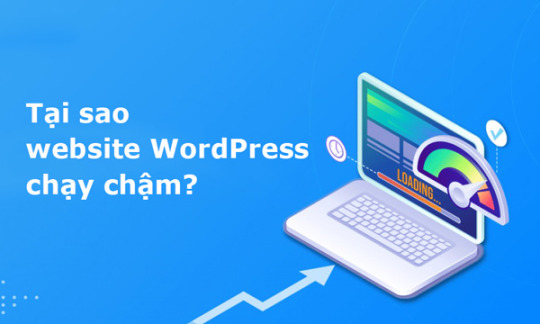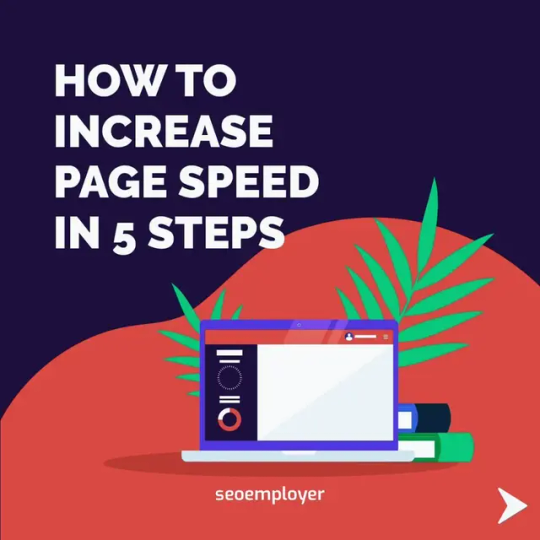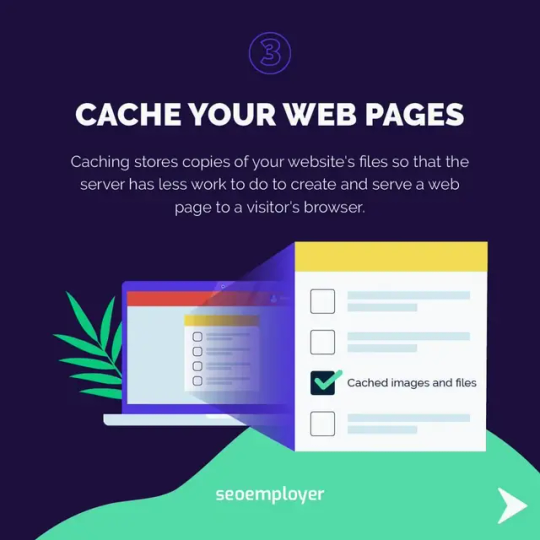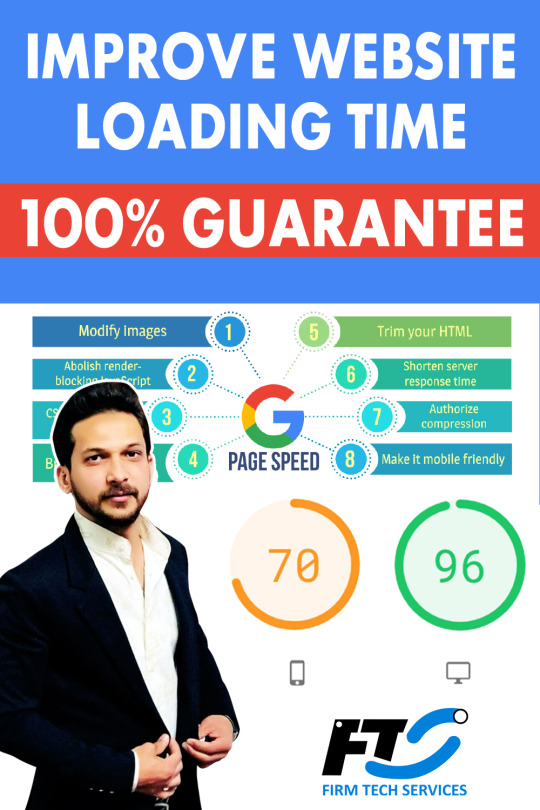#wordpressspeed
Explore tagged Tumblr posts
Text
Do you need to fix any html, css, javascript, wordpress, php errors, website bugs or issues fast ?

#webdevelopers#responsivewebsite#websitedesign#psdtohtml#websitedevelopment#landingpage#HTML#CSS#customwebsite#buildwebsite#staticwebsite#issues#bugfix#html#css#javascript#bootstrap#php#WordPress#frontenddeveloper#wordpressfixes#phpbugfixing#copywebsite#redesignwebsite#clonewebsite#duplicatewebsite#wordpressoptimize#wordpresspagespeed#websitespeed#wordpressspeed
2 notes
·
View notes
Text

🚀 Slow Website? It’s Killing Your Conversions.
Did you know? A 1-second delay in page load time can reduce conversions by up to 20%.
Here’s how our WordPress Speed Optimization service helps:
⚡ Core Web Vitals Optimized We fine-tune your site to pass Google’s performance benchmarks.
🧹 Code & Database Cleanup Remove bloat. Compress files. Optimize queries. Cleaner code = faster site.
📷 Next-Gen Image Optimization WebP and lazy loading keep image-heavy pages lightning-fast.
🔧 Caching + CDN Integration Smart caching & global CDN = blazing load times for global users.
🔍 GTmetrix + PageSpeed Reports We don’t guess—we deliver results you can see with real tools.
✅ Up to 90% Speed Score Guaranteed
📈 Pro Tip: A faster WordPress site doesn’t just improve UX—it boosts SEO rankings and reduces bounce rate.
👉 Ready to optimize your website’s performance? Explore our Speed Optimization Service now.
0 notes
Text
Boost WordPress Speed: How Media Cleaner and DB Optimizer Plugins Help
In today’s digital age, website speed isn't just a luxury — it’s a necessity. A slow-loading WordPress site can hurt your SEO rankings, increase bounce rates, and ultimately drive away potential customers. Fortunately, two powerful plugins — Media Cleaner and a Database Optimizer — can significantly improve your WordPress website performance by removing unnecessary bloat and streamlining operations.
In this comprehensive guide, we’ll dive into how these plugins work, why they matter, and how to use them effectively to supercharge your WordPress site’s speed.

Why WordPress Speed Matters
Before diving into the tools, let’s understand why speed is so crucial:
Better SEO rankings: Google uses site speed as a ranking factor.
Improved user experience: Users expect a website to load in 2 seconds or less.
Higher conversions: Faster websites convert better — even a 1-second delay can reduce conversions by 7%.
Lower bounce rates: Visitors tend to abandon slow-loading sites.
In short, optimizing your site speed is one of the easiest and most cost-effective ways to improve your site’s performance.
What Slows Down WordPress Sites?
Many factors can contribute to a sluggish WordPress website:
Unused or oversized media files (images, videos, PDFs).
Database bloat from spam comments, revisions, transients, and outdated entries.
Poorly coded plugins or themes.
Large post or page content with unnecessary formatting or embeds.
Unoptimized hosting or lack of caching/CDN.
This is where Media Cleaner and Database Optimizer plugins come in.
Introducing Media Cleaner: What It Does
Media Cleaner is a WordPress plugin designed to help you identify and remove unused media files from your WordPress library.
🔍 Key Features:
Scans your WordPress media library to detect unused images and files.
Identifies broken or orphaned media not attached to any post, page, or product.
Deletes unnecessary files, freeing up storage and improving performance.
Compatible with WooCommerce, page builders, and media galleries.
🧠 How It Works:
When you upload an image or file to WordPress, it’s stored in the media library, even if you don’t end up using it. Over time, these unused files accumulate and clutter your site — especially for blogs, eCommerce sites, and portfolio websites with high media usage.
Media Cleaner performs a deep scan of your posts, pages, widgets, and metadata to find files that aren’t being used. Once identified, you can review and safely delete them.
Introducing Database Optimizer Plugins
A Database Optimizer plugin is essential for keeping your WordPress database lean and fast. Popular options include:
WP-Optimize
Advanced Database Cleaner
Optimize Database after Deleting Revisions
WP-Sweep
For this guide, we’ll focus on the functionality more than a specific brand.
Key Features:
Cleans post revisions, spam comments, orphaned metadata, and trash.
Removes expired transients (temporary cached data).
Optimizes database tables to reduce overhead and improve queries.
Scheduled cleanups and automation for ongoing optimization.
Why Your Database Needs Cleaning
Every time you save a draft, approve a comment, or update a plugin, WordPress stores a record in the database. These records accumulate and cause database bloat, which slows down queries and page load times.
Database optimizers eliminate unnecessary data while preserving important content, resulting in a faster and more efficient backend.
How Media Cleaner and DB Optimizer Work Together
While both plugins serve different purposes, using them together delivers synergistic performance gains.
Task
Media Cleaner
DB Optimizer
Deletes unused images/files
✅
❌
Cleans post revisions, spam, etc.
❌
✅
Improves server space
✅
✅
Boosts backend performance
✅
✅
Reduces site bloat
✅
✅
When combined, they reduce the load on your hosting environment, minimize the size of your backup files, and make your site faster and easier to maintain.
Step-by-Step: How to Use Media Cleaner
Here’s how to start cleaning up your WordPress media library:
1. Install the Plugin
Go to Plugins > Add New, search for Media Cleaner, and click Install Now, then Activate.
2. Perform a Scan
Navigate to Media > Media Cleaner and click Scan. The plugin will search for unused files.
3. Review Results
Before deleting, manually review the files to make sure nothing important is incorrectly flagged.
4. Delete Unused Media
Click Delete All or select files to delete individually.
Pro Tip: Always take a backup before deleting any media, especially on a live site.
Step-by-Step: How to Use a Database Optimizer
Let’s use WP-Optimize as an example, although other plugins work similarly.
1. Install and Activate
Go to Plugins > Add New, search for WP-Optimize, install and activate.
2. Go to WP-Optimize Settings
You’ll see a new section under WP-Optimize > Database.
3. Select What to Clean
Check items like:
Clean all post revisions
Remove auto-draft posts
Clean spam and trashed comments
Remove expired transients
4. Run Optimization
Click Run Optimization. The plugin will clear selected data and optimize database tables.
5. Schedule Future Cleanups (Optional)
Enable automated weekly or monthly cleanup under the Settings tab.
Safety Tips When Using These Plugins
Although these plugins are powerful, use them with caution:
✅ Backup your site before making changes.
✅ Test on a staging site if available.
✅ Don’t delete files linked via custom code or plugins.
❌ Avoid deleting media files immediately after scanning; review results first.
❌ Don’t run multiple database optimizers at the same time.
Performance Gains: What to Expect
After using Media Cleaner and a DB Optimizer, you may notice:
Faster page loads
Reduced server resource usage
Lower backup sizes
Improved GTmetrix or PageSpeed Insights scores
Better experience for mobile users
Even small improvements (e.g., reducing page load time from 4s to 2.5s) can result in higher engagement and more conversions.
Alternatives & Honorable Mentions
Here are a few other optimization plugins worth exploring:
Smush or ShortPixel (for image compression)
Asset CleanUp or Perfmatters (for script optimization)
LiteSpeed Cache or WP Rocket (for caching)
Regen. Thumbnails (if you regenerate thumbnail sizes)
Combine these with Media Cleaner and DB Optimizer for a full-stack performance strategy.
Final Thoughts
Your WordPress site doesn’t have to be slow. Often, the issue isn’t your hosting or theme — it’s the unwanted clutter in your media library and database.
By using Media Cleaner and a Database Optimizer plugin, you can:
Reduce load times Free up storage Improve SEO Create a better user experience
Whether you're running a personal blog, an eCommerce store, or a content-heavy site, these tools can make a big impact with minimal effort.
0 notes
Text
TẠI SAO WEBSITE WORDPRESS CHẠY CHẬM?
Website WordPress của bạn tải ì ạch, khiến khách thoát trang chỉ sau vài giây? Nguyên nhân có thể không nằm ở hosting, mà do: ❌ Cài quá nhiều plugin nặng ❌ Giao diện tối ưu kém ❌ Không dùng bộ nhớ đệm (cache) ❌ Ảnh chưa nén đúng cách ❌ Mã độc ẩn trong hệ thống
👉 Đừng để tốc độ website giết chết chuyển đổi! Inb ngay để chúng tôi giúp bạn tối ưu toàn diện, tăng tốc chỉ sau 24h! ⚡

Chi tiết bài viết: https://hungwordpress.com/tai-sao-website-wordpress-chay-cham/
#WordPress#TốiƯuWebsite#TăngTốcWebsite#WebChạyChậm#TăngChuyểnĐổi#WordPressSpeed#PluginNặng#LỗiWebsite#ThiếtKếWebsite#SEO#DigitalMarketing
0 notes
Text
How to speed up your WordPress website with proven tips and tools:
✅ Optimize load times ✅ Improve user experience ✅ Boost Google rankings 🔗
💼 Need expert help? Hire a WordPress developer to turbocharge your site performance today!
#WordPressSpeed#WebsitePerformance#SpeedOptimization#WordPressDeveloper#WebDevTips#PageSpeed#CreoleStudios#WordPressHelp
0 notes
Text

Speed up your WordPress site with the best CDN services! 🚀
Explore top picks like Cloudflare, KeyCDN, and more. Whether you're looking for speed, security, or simplicity, we've got you covered. 📖
Click the link 👉 https://bit.ly/4aU10xp to learn more about how to boost your website's performance effortlessly!
0 notes
Text
1 note
·
View note
Text
To increase you webpage speed, you need to follow these steps,
#pagespeed #pagespeedinsights #seotechnique #websitespeed #sslcertificate #technicalseo #imagecompression #onpageseo #wordpressspeed #newthingsindigital #seo #digitalmarketing #searchengineoptimization #contentmarketing #socialmediamarketing #digitalmarketingagency #sem #onlinemarketing #seotips #socialmedia #digitalmarketing #socialmediamarketing #marketing #digitalmarketingagency #seo #onlinemarketing #marketingstrategy #socialmedia #contentmarketing #digitalmarketingtips #seoemployer






0 notes
Text
youtube
The Plugin Overload Problem You have 47 plugins 'improving' your website while they're actually destroying it! Every plugin is a speed vampire Learn all my Google Secrets for free, get it now: https://ift.tt/5qdcTVY ✅ Important Links to Follow - Google Audit: https://ift.tt/V6odJT9 - Google Ads Management: https://ift.tt/N1IRCov - SEO Website Update: https://ift.tt/KXBp1EJ - Visit for digital resources: https://ift.tt/wt0vLai - Join a free community: https://ift.tt/0dpBSog 🔔𝐃𝐨𝐧'𝐭 𝐟𝐨𝐫𝐠𝐞𝐭 𝐭𝐨 𝐬𝐮𝐛𝐬𝐜𝐫𝐢𝐛𝐞 𝐭𝐨 𝐦𝐲 𝐜𝐡𝐚𝐧𝐧𝐞𝐥 𝐟𝐨𝐫 𝐦𝐨𝐫𝐞 𝐮𝐩𝐝𝐚𝐭𝐞𝐬. https://www.youtube.com/@kaeraemarketing/?sub_confirmation=1 🔗 Stay Connected With Me. Facebook: https://ift.tt/ea0oSVx Instagram: https://ift.tt/mLjhSrX Tiktok: https://ift.tt/5xK6Fpv Linkedin: https://ift.tt/tx2Z5nG Pinterest: https://ift.tt/a6IstlV Website: https://ift.tt/JEKc870 📩 For business inquiries: [email protected] ============================= 🎬Suggested videos for you: ▶️ https://youtu.be/8ld3_DuQqXg ▶️ https://youtu.be/XOYPpbh3zaY ▶️ https://youtu.be/mQJoodRwM84 ▶️ https://youtu.be/xex_HqP0QWU ▶️ https://youtu.be/p_x_ubfygfM ▶️ https://youtu.be/pFkiL4fh6o0 ▶️ https://youtu.be/00tcBgRxjAI ▶️ https://youtu.be/Lc-F8HzoyFY ▶️ https://youtu.be/poLpFGWBvFM ▶️ https://youtu.be/E8mUUvMsUmU ▶️ https://youtu.be/d-o5pv-HDFw ▶️ https://youtu.be/NTdbrijJKyM ▶️ https://youtu.be/I5sxI9RaHXY ================================= ✅ About Kelsey Flannery (KaeRae Marketing). Welcome! I’m Kelsey Flannery, also known as KaeRae, a Google Ads expert helping business owners navigate Google tools with ease. Through simple, informative videos, I provide guidance on Google Analytics, Google Ads, Google Business, Search Console, Tag Manager, YouTube Ads, Local Services Ads, Merchant Center, and more. As the owner of KaeRae Marketing, Inc., I provide results-driven marketing for home service businesses and eCommerce. Certified in key Google tools, I specialize in lead generation, PPC advertising, and online growth strategies. Let’s maximize your business’s online reach and drive real results! For Business inquiries, please use the contact information below: 📩 Email: [email protected] 🔔 Struggling with Google Analytics, Ads, or SEO? Subscribe for expert tips, effective strategies, & the best tools on PPC, lead generation, and maximizing your online reach! https://www.youtube.com/@kaeraemarketing/?sub_confirmation=1 ================================= 🔎 Related Phrases: WordPress Speed, Plugin Cleanup, Website Optimization, Site Speed Hashtags: #WordPressSpeed #PluginCleanup #WebsiteOptimization #SiteSpeed via Kelsey Flannery (KaeRae Marketing) https://www.youtube.com/channel/UCji8NuY6sx7RVYD85k_XJlQ June 19, 2025 at 11:01PM
#googleads#googleadwords#digitalads#ppcadvertising#digitalmarketing#businessgrowth#keywordsresearch#googlebusiness#Youtube
0 notes
Text
🚀 Tired of a slow WordPress website? Let GPADICT supercharge it! 🔧⚡ Is your website taking ages to load? Visitors leaving before it even opens? ➡️ You’re losing traffic, sales & SEO rankings!
At GPADICT, we optimize WordPress speed like pros. We ensure your site is lightning-fast, fully optimized, and ready to impress.
✅ Website load time under 3 seconds ✅ Image and file optimization ✅ Cache setup & CDN integration ✅ Database cleanup ✅ Theme & plugin optimization ✅ Mobile performance boost ✅ Google PageSpeed & GTMetrix improvement
🎯 Perfect for: 👉 E-commerce stores 👉 Blogs 👉 Corporate websites 👉 Portfolio sites
📞 Get a FREE Speed Audit today! 📩 Inbox us now or visit our site: https://www.fiverr.com/gpadict?public_mode=true https://www.behance.net/gpadict https://www.pinterest.com/gpadict/ https://x.com/GpadIct https://www.tumblr.com/blog/gpadict
WordPressSpeed #WebsiteOptimization #GPADICT #FasterWebsite #WordPressFix
#web development#website#website management#wordpress development#website development#web design#web development company#websitedevelopment#wordpress#portfolio
0 notes
Text
Do you need wordpress site speedy and well optimized with excellent a grade performance ?

#webdevelopers#responsivewebsite#websitedesign#psdtohtml#websitedevelopment#landingpage#HTML#CSS#customwebsite#buildwebsite#staticwebsite#issues#bugfix#html#css#javascript#bootstrap#php#WordPress#frontenddeveloper#wordpressfixes#phpbugfixing#copywebsite#redesignwebsite#clonewebsite#duplicatewebsite#wordpressoptimize#wordpresspagespeed#websitespeed#wordpressspeed
2 notes
·
View notes
Text
Website Speed Optimization


Website Speed Optimization
1. Large Image Files
Problem: Large images significantly slow down website loading times.
Solution: Compress images using tools like TinyPNG or convert them to modern formats like WebP. Could you make sure images are properly scaled to fit their display size?
2. Unoptimized CSS and JavaScript
Problem: Bloated CSS and JavaScript files can delay rendering and slow down page speed.
Solution: Minify CSS and JavaScript files to reduce their size and remove unnecessary code. Tools like CSSNano and UglifyJS can help.
3. Slow Server Response Time
Problem: A slow server results in delayed page load times, negatively affecting user experience.
Solution: Choose a reliable hosting provider with optimized servers or upgrade to a dedicated server or VPS for faster response times.
4. Too Many HTTP Requests
Problem: Each file (e.g., CSS, JavaScript, images) requires an HTTP request, and too many requests slow down the loading process.
Solution: Reduce the number of files by combining CSS/JavaScript files and using sprites for images. Enable HTTP/2 for faster simultaneous requests.
5. Excessive Plugins (WordPress)
Problem: Too many plugins, especially poorly coded ones, can slow down a website's speed.
Solution: Deactivate and delete unnecessary plugins, and only use well-optimized, essential ones.
6. No Lazy Loading for Images
Problem: Loading all images at once slows down the initial page load time.
Solution: Implement lazy loading so that images load only when they appear in the user’s viewport. Many frameworks and plugins support this feature.
7. Lack of Mobile Optimization
Problem: Mobile users may experience slower speeds if the site is not optimized for mobile devices.
Solution: Implement responsive design, compress images for mobile, and prioritize mobile-friendly CSS.
the
Uttom Roy
#WebsiteSpeed#SpeedOptimization#PageSpeed
#WebPerformance#SEO#PerformanceOptimization
#WebsitePerformance#FasterWeb#SpeedUpYourSite
#LoadingTime#WordPressSpeed#WebsiteAudit
#WebOptimization#SiteSpeed#GooglePageSpeed#CoreWebVitals#TTFB#ImageOptimization#CSSOptimization
#LazyLoading#MobileOptimization#FastLoading
#OptimizeForSpeed#PageLoad#WebCaching
#HostingPerformance#SpeedTest#WebDesignOptimization#WebDevTips#CoreWebVitals #BoostPerformance
#FastWebsite #WordPressOptimization
লাইক করুন
কমেন্ট করুন
শেয়ার করুন
#companies#report#newspaper#seo services#business#internet#fintech#management#banking#news#uttomseomaster#uttomroyseoexpert
0 notes
Text
Boost WordPress Performance: Why Disabling Services Manager Plugin Helps
When it comes to optimizing your WordPress website for performance, security, and privacy, one often overlooked solution is to Disable Services Manager Plugin. Many site owners install plugins without realizing the potential overhead they can add to loading times, server resources, and even security vulnerabilities.
In this guide, we’ll break down what the Services Manager plugin is, why disabling it could be beneficial, and how to do it the right way without breaking your site.

What Is the Services Manager Plugin?
The Services Manager plugin in WordPress acts as a centralized module that controls and manages external and internal services. This includes anything from API calls, data sharing modules, and sometimes even telemetry or third-party integration services.
While its purpose is to streamline service management, not every WordPress site actually needs this plugin. In fact, it can become a performance bottleneck, especially if you’re running a lightweight site or one with a custom setup.
Why You Should Disable Services Manager Plugin
Let’s take a closer look at why you might want to Disable Services Manager Plugin to enhance your WordPress site’s performance:
1. Improve Website Speed
Every plugin you activate adds to your site’s backend and frontend processing. The Services Manager plugin often makes background calls and service checks that can slow down page loading times. By disabling it, you can remove unnecessary resource consumption and reduce the time it takes for your website to render.
Example: If your Services Manager plugin is connecting to third-party APIs or collecting data, these background operations can delay page generation, particularly on shared hosting environments.
2. Strengthen Security
One of the critical aspects of maintaining a secure WordPress website is minimizing your attack surface. Each plugin represents a potential entry point for hackers, especially if it’s not frequently updated or widely used.
The Services Manager plugin, depending on its configuration, may open external communication channels, making your site vulnerable to external exploits.
3. Enhance Privacy Compliance
With growing concerns around GDPR, CCPA, and other privacy laws, it’s vital to control what data your site is collecting or sending to third parties. If the Services Manager plugin facilitates background tracking or telemetry, it could put your site at risk of non-compliance.
Disabling the plugin helps in maintaining full control over data flow and user privacy.
4. Reduce Plugin Bloat
WordPress sites thrive on simplicity. The more plugins you have, the harder it is to maintain your website. If you’re not actively using the Services Manager plugin for essential tasks, it’s just digital clutter.
By choosing to Disable Services Manager Plugin, you streamline your site’s backend and reduce conflicts between plugins.
Signs You Should Disable the Services Manager Plugin
Not sure if this plugin is causing issues? Here are a few tell-tale signs:
Sluggish site speed even after caching and optimization.
Increased server load or high CPU usage without clear reason.
Unnecessary outbound API calls you didn’t configure.
Privacy or compliance red flags from audits or legal tools.
Errors in your error_log file pointing to the services manager.
How to Disable Services Manager Plugin Safely
Disabling a plugin might sound simple, but it’s important to do it the right way to prevent any disruptions on your website.
Step 1: Backup Your Website
Before making any changes, always take a full backup of your site. Use plugins like UpdraftPlus, Jetpack, or manually back up using your hosting cPanel or FTP.
Step 2: Identify Dependencies
Some themes or plugins might rely on the Services Manager plugin. Check if anything else is dependent on it by reviewing plugin documentation or developer notes.
Step 3: Disable the Plugin
Login to your WordPress admin dashboard.
Navigate to Plugins > Installed Plugins.
Locate Services Manager and click Deactivate.
If no issues arise after deactivation, click Delete to remove it.
Step 4: Test Your Website
After deactivation, visit the front-end and check if:
All key features work properly.
No unexpected layout changes or errors occur.
Website speed improves (use GTmetrix or PageSpeed Insights to compare).
Alternatives to Services Manager Plugin
If you still need to manage services or integrations but want a more optimized solution, consider lightweight or modular plugins. Here are some recommendations:
WP Crontrol: Manage and monitor scheduled tasks with precision.
Code Snippets: Add service-related code snippets without needing a full plugin.
REST API Toolbox: Control how your site interacts with external services via REST.
These tools are more streamlined and offer targeted functionalities, which avoids unnecessary bloat.
Real-World Case Study
A tech blog using the Services Manager plugin noticed increasing bounce rates due to slow page load times. After a performance audit, the plugin was identified as making frequent third-party API checks, even for unused integrations.
Upon choosing to Disable Services Manager Plugin, the website saw:
35% faster load times.
20% reduced server resource usage.
Improved Core Web Vitals scores in Google Search Console.
Increased user engagement and time on page.
SEO and Performance Gains from Disabling the Plugin
WordPress SEO is heavily tied to speed and user experience. When Google indexes your site, it evaluates performance metrics like loading time, interactivity, and content stability.
Here’s how disabling the plugin can give you an SEO edge:
Faster Load Times = Higher Rankings: Speed is a confirmed ranking factor.
Fewer JS Calls = Better Mobile Usability: Services Manager may inject scripts you don’t need.
Improved Crawl Budget: Googlebot can crawl more pages in less time on a leaner site.
Common Questions About Disabling Services Manager Plugin
Q1. Will disabling the plugin break my website?
Only if other plugins or themes are dependent on it. Perform a compatibility test first.
Q2. Can I disable it temporarily?
Yes. You can deactivate it and observe your site behavior. If nothing breaks, it's safe to delete it permanently.
Q3. Is there any risk to SEO?
Not if the plugin isn’t providing core SEO features. In fact, your SEO may improve due to better speed and performance.
Final Thoughts: Should You Disable Services Manager Plugin?
If your WordPress site doesn’t rely on the Services Manager for critical operations, it’s often a good idea to disable it. Doing so can lead to better speed, tighter security, and cleaner code—all of which are essential for a modern, optimized WordPress site.
To get a complete walkthrough and more reasons why you should Disable Services Manager Plugin, check out our detailed guide.
By making smart choices around plugins and only keeping what you truly need, you’re setting your site up for long-term success.
0 notes
Link
I will speed up wordpress website speed optimization increase google page speed
#wordpress#wordpressspeed#wordpress speed optimization#wordpress speed#fiverr#google page speed#gtmetrix
1 note
·
View note
Link

#wordpress#wordpressspeedoptimization#wordpressspeed#improveyourWordPressSpeedNow#ConvertPSDXDtoWordPressresponsivedesign.#wordpres#fts service#fts_services#fts_service#logo design fts#fts services fiverr#fts#fiverr#https://www.fiverr.com/share/1Woga4#fiver#rankyourfiverrgig#word#yourspeedslow#websitespeed#speed optimization#speed up boot time windows 10#how to increase cpu speed windows 10#speed#speedway
2 notes
·
View notes
Text

Looking to enhance your WordPress website?
We've compiled essential tips to improve speed, security, and user experience on your site. 🛠💼 Whether you're a beginner or a seasoned pro, our latest blog post has something for everyone.
Click the link 👉 https://bit.ly/3UXufea to explore how you can take your WordPress site to the next level!
#developer#webdev#coding#programming#webdesign#wordpressspeed#wordpresssecurity#uxdesign#beginnerfriendly#wordpresstipsandtricks
0 notes